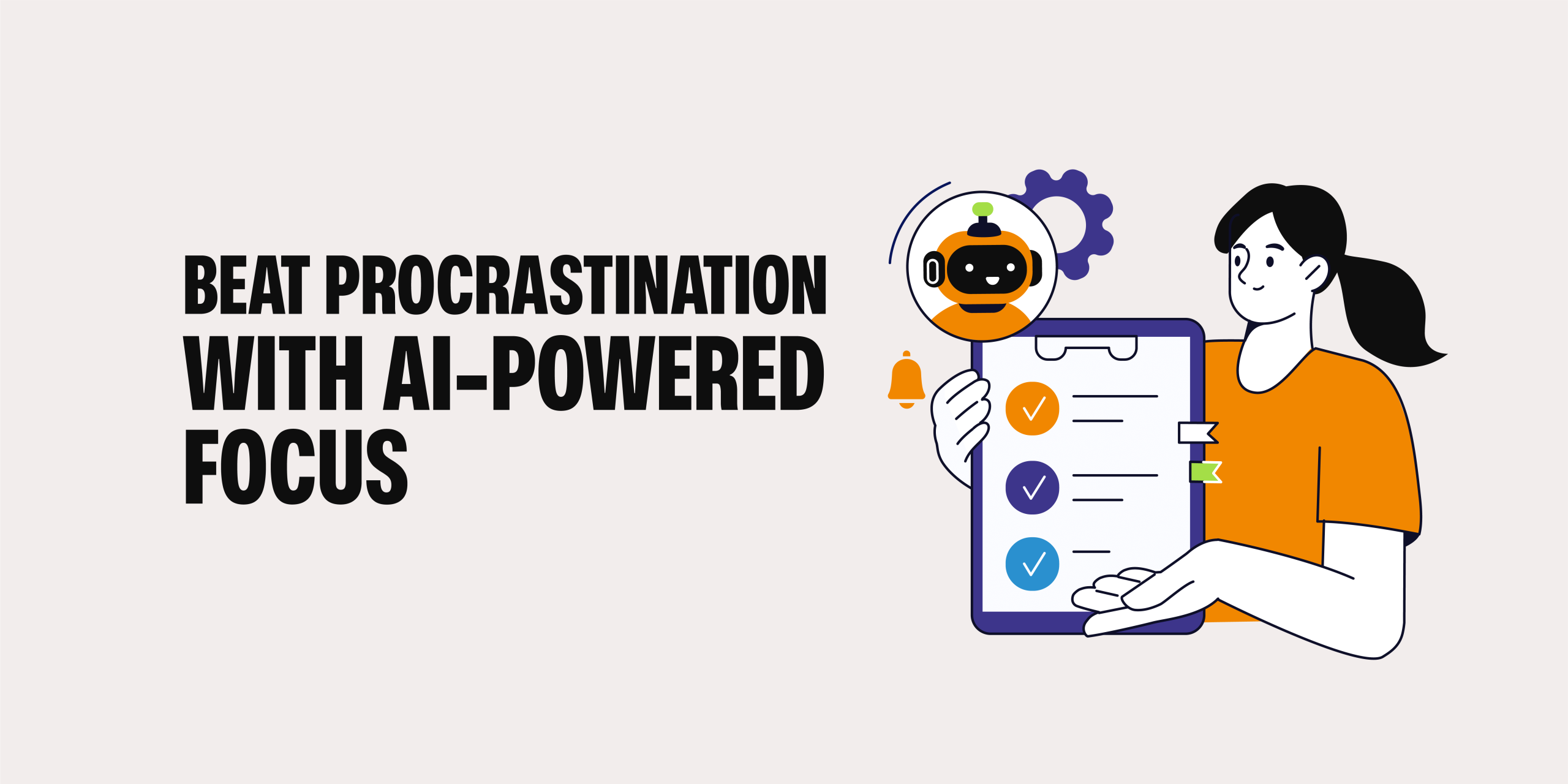Procrastination—the age-old nemesis of productivity. It creeps in during our busiest days and whispers, “Just five more minutes on social media.” Before we know it, the hours have slipped away. It’s not just about losing time; procrastination can leave us feeling stressed, guilty, and unfulfilled. And in a world where every minute counts, these feelings can take a toll on our personal and professional lives.

But what if we told you there’s a way to not only combat procrastination but to transform it into purposeful action? What if technology, particularly AI-powered time management, could become your ally in reclaiming your time and energy?
AI, with its intelligent tools and systems, offers an innovative approach to tackling procrastination. It doesn’t just manage your tasks; it learns your habits, understands your goals, and helps you build a personalized time management system that works for you. This isn’t about adding another app to your phone—it’s about revolutionizing how you approach productivity and creating a life aligned with your values and aspirations.
In this article, we explore how leveraging AI-powered tools can revolutionize your approach to productivity. From creating an effective time management system to adopting an AI task scheduler, we’ll uncover practical strategies to transform your habits and align your days with your greater purpose.
1. Why Do We Procrastinate? Understanding the Root Causes
Before diving into solutions, it’s essential to understand why we procrastinate. Contrary to popular belief, it’s not just laziness. Procrastination often stems from fear—fear of failure, perfectionism, or simply feeling overwhelmed. At its core, procrastination is a coping mechanism, a way to avoid tasks that feel daunting or emotionally taxing. Recognizing these triggers is the first step toward change.

The Emotional Weight of Procrastination
Procrastination can weigh heavily on us. Tasks pile up, leading to stress, guilt, and a sense of being stuck in a loop. Over time, this creates a mental burden that can affect our overall well-being and productivity. But here’s the good news: there’s a way out. By understanding these feelings and addressing them directly, we can take control of our time and energy.
If you want to make progress on your number one priority, you’ll need to make it your focus whenever possible.
Jake Knapp & John Zeratsky, Make Time
The Role of Habit and Environment
Procrastination often thrives in environments filled with distractions. From constant notifications to cluttered workspaces, external factors can contribute to delayed actions. Similarly, habits play a huge role. For instance, associating certain spaces with relaxation rather than work can make it harder to focus. Building awareness of these triggers allows us to take proactive steps to reshape our routines.
Make Time is not about productivity. It’s not about getting more done, finishing your to-dos faster, or outsourcing your life. Instead, it’s a framework designed to help you actually create more time in your day for the things you care about.
Charles Duhigg, Smarter Faster Better
Breaking the Cycle with Technology
Imagine a compassionate assistant who helps you break tasks into manageable steps, keeps you on track, and nudges you gently when you’re distracted. That’s exactly what AI for time management tools do—they’re like a collaborative partner in your journey toward greater productivity. These tools not only help in organizing tasks but also adapt to your specific needs, offering support where it’s needed most. By integrating such technology into your routine, you can build momentum and transform procrastination into progress.
Your conscious mind, like the computer screen, is a focusing tool, not a storage place. You can think about only two or three things at once. But the incomplete items are still being stored in the short-term-memory space. And as with RAM, there’s limited capacity; there’s only so much ‘stuff’ you can store in there and still have that part of your brain function at a high level.
David Allen, Getting Things Done
2. The Evolution of Time Management: From Paper Planners to AI-Powered Tools

Time management has evolved dramatically over the years. What started with simple pen-and-paper planners—those trusty notebooks where people jotted down tasks and appointments—has now transitioned to sophisticated digital systems. In earlier decades, tools like calendar apps and task management software brought a new level of organization, but today, we’re entering a new frontier: AI-powered tools that revolutionize productivity.
How AI Fits into the Picture
At its core, AI excels in analyzing patterns, predicting needs, and automating repetitive tasks. Unlike traditional time management tools, AI doesn’t just help you schedule—it learns from your habits.
Human beings have an innate inner drive to be autonomous, self-determined, and connected to one another. And when that drive is liberated, people achieve more and live richer lives.
Daniel Pink, Drive
For example, AI scheduling software can detect when you’re most productive and arrange tasks accordingly, while also factoring in external commitments.
AI is especially valuable in addressing the modern-day challenges of time management. As workloads grow and distractions multiply, people need tools that can adapt dynamically. An AI system doesn’t just create a static to-do list; it creates a living, breathing schedule that evolves with your day.
A Glimpse at AI’s Impact
The impact of AI on time management is profound. Here are just a few examples of how it’s reshaping productivity:
- AI task management tools streamline workflows by prioritizing tasks based on urgency, deadlines, and complexity. These tools even provide actionable recommendations to optimize your daily output.
- AI calendar assistants go beyond simple reminders by analyzing your calendar for potential conflicts, finding the best slots for meetings, and ensuring you have ample time for deep work.
- AI time tracking doesn’t just log hours; it gives you detailed insights into how your time is spent, helping you identify inefficiencies and adjust your approach. These insights can be transformational, enabling you to spend more time on high-value activities.
From Static Systems to Dynamic Solutions
The shift from manual planning to AI-driven systems signifies a move from rigidity to adaptability. Traditional planners required users to manually adjust schedules when things didn’t go as planned. In contrast, AI tools dynamically reorganize tasks in response to changes, ensuring that your priorities remain intact even when disruptions occur.
This evolution is more than just a technological leap; it’s a paradigm shift. Time management is no longer about strict discipline and rigid schedules. With AI, it’s about creating a fluid, responsive system that aligns with your natural rhythms and unique demands. The result? A smarter, more balanced way to navigate your days.
3. Exploring the Benefits of AI Time Management

Why should you embrace AI in your quest to beat procrastination? The answer lies in its transformative potential to optimize your time, simplify your tasks, and reduce stress. Let’s delve deeper into some compelling benefits that AI time management brings to the table:
1. Personalized Time Management Systems
AI doesn’t believe in one-size-fits-all. Tools like AI-powered scheduling and AI daily planners adapt to your unique workflow, analyzing your habits to create solutions tailored to your specific needs.
Our “default setting” is to be autonomous and self-directed. Unfortunately, circumstances—including outdated notions of ‘management’—often conspire to change that default setting and turn us from Type I to Type X.
Daniel Pink, Drive
Unlike traditional methods, these tools don’t just help you track time; they actively work to enhance how you use it. By identifying your peak productivity hours, they help you align challenging tasks with your energy levels, ensuring you operate at your best.
2. Breaking Down Complex Tasks
Ever felt paralyzed by a big project that seems too daunting to even start? AI that breaks down tasks provides the structure you need to move forward. These tools analyze large goals and divide them into manageable, bite-sized steps, reducing overwhelm. For instance, an AI task scheduler can take a massive presentation and outline a clear plan, from research to slide creation, with suggested deadlines for each phase. This level of organization makes even the most intimidating tasks feel achievable.
The habit of clarifying the next action on projects, no matter what the situation, is fundamental to you staying in relaxed control.
David Allen, Getting Things Done
3. Eliminating Decision Fatigue
Decision-making, especially for small yet numerous tasks, can drain your mental energy. AI steps in as a productivity partner, handling routine decisions so you can focus on what truly matters.
Busyness as Proxy for Productivity: In the absence of clear indicators of what it means to be productive and valuable in their jobs, many knowledge workers turn back toward an industrial indicator of productivity: doing lots of stuff in a visible manner.
Cal Newport, Deep Work
By using AI calendar planners and AI-powered calendars, you can delegate scheduling and prioritization to technology. For example, AI can recommend when to schedule focus blocks for deep work or alert you when a meeting clashes with essential prep time. Over time, this reduces the cognitive load, allowing you to approach each day with clarity.
4. Enhancing Accountability and Consistency
One of the often-overlooked benefits of AI is its ability to act as a virtual accountability partner. With regular reminders and progress tracking, AI ensures you stay on course. Tools like AI time tracking provide actionable insights into how you’re spending your time, highlighting areas for improvement. This consistent feedback loop encourages accountability and helps establish habits that promote long-term productivity.
5. Encouraging Work-Life Balance
In our pursuit of productivity, it’s easy to neglect personal well-being. AI tools are increasingly being designed to prioritize balance by setting boundaries. For example, an AI-powered calendar can suggest breaks, flag overbooked schedules, and recommend realistic time blocks for personal activities. This feature is crucial for avoiding burnout and fostering a sustainable work-life rhythm.
The benefits of AI time management go far beyond mere convenience. They represent a shift toward smarter, more intentional living, where technology supports our aspirations and aligns with our values. By integrating these tools into your routine, you can unlock new levels of focus, creativity, and fulfillment.
4. Tools That Can Transform Your Productivity

If you’re ready to explore the world of AI time management, here’s a comprehensive roundup of tools that can make a difference in various aspects of your productivity journey:
1. Best AI Time Management Tools
- ClickUp:
What it is: An all-in-one platform for AI time blocking, tracking progress, and setting clear goals. ClickUp is designed to cater to individuals and teams, offering a comprehensive productivity solution.
How it works: ClickUp uses advanced AI to analyze your tasks and workflows, suggesting optimal ways to organize and prioritize. It provides detailed visualizations of your workload, integrates seamlessly with other apps, and adjusts to fit your specific style of working.
Accessibility: ClickUp offers a free version with limited features, making it accessible for individual users or small projects. Premium plans with advanced features provide scalable options for larger teams. - Notion AI:
What it is: A versatile workspace that combines collaboration, task management, and AI-enhanced notes, ideal for both personal and professional use.
How it works: Notion AI assists in brainstorming ideas, outlining projects, and even generating content. It analyzes your input and provides contextually relevant suggestions, making it an excellent choice for creative and analytical tasks.
Accessibility: The base version of Notion is free, with AI features included in premium plans, making it an affordable option for small teams and individuals. - RescueTime:
What it is: A productivity assistant designed to provide detailed insights into how you spend your time and help you optimize your focus.
How it works: RescueTime tracks your activities in the background, categorizing them and providing distraction alerts. It also generates focus reports that highlight your productivity patterns, helping you identify areas for improvement.
Accessibility: RescueTime offers a free basic plan with time tracking and reports. Premium features, including focus sessions and detailed analysis, are available as well.
2. AI Task Management Tools
- Trello AI:
What it is: An AI-enhanced project management tool that simplifies task organization and team collaboration. Trello is known for its intuitive interface and card-based system.
How it works: Trello AI suggests deadlines, assigns tasks intelligently, and provides real-time updates on project milestones. It also offers automation for repetitive tasks, such as moving cards or sending notifications based on conditions you set.
Accessibility: Trello offers a free plan suitable for individuals or small teams. Paid plans with additional features cater to larger teams or complex projects. - Asana AI:
What it is: A powerful tool for prioritizing tasks and optimizing workflows, designed to support teams of all sizes.
How it works: Asana AI highlights critical tasks, tracks dependencies, and generates efficient workflows to help teams stay aligned on goals. Its automation features ensure that project updates are seamless and intuitive.
Accessibility: Asana offers a free version with basic task management features. Premium plans with advanced AI capabilities are available for purchase too.
3. AI Scheduling Assistants
- Motion:
What it is: A dynamic AI-powered scheduling tool that integrates task management with advanced calendar features, ideal for professionals juggling multiple priorities.
How it works: Motion intelligently analyzes your schedule, rearranging tasks in real time based on urgency, deadlines, and your availability. It ensures your day stays balanced, even when unexpected tasks arise.
Accessibility: Motion offers a free trial, with premium plans, making it suitable for users seeking a high level of customization and adaptability. - Calendly AI:
What it is: A scheduling assistant that streamlines meeting arrangements and helps maintain work-life balance.
How it works: Calendly AI analyzes your preferences, detects conflicts, and suggests the best times for meetings. It can also automatically schedule breaks to ensure you don’t overbook yourself.
Accessibility: Calendly provides a free basic plan for simple scheduling needs, with premium plans available for per user per month.
4. Apps to Help with Procrastination
- Focus@Will:
What it is: An app that curates AI-generated music playlists to enhance focus and reduce distractions, tailored to different work styles.
How it works: Focus@Will uses neuroscience principles to create personalized soundtracks. By analyzing your focus patterns, it selects music that helps you enter a flow state and maintain concentration for longer periods.
Accessibility: A free trial is available to test its features. Subscription plans offer options for individuals and teams. - Forest App:
What it is: A gamified productivity app that encourages you to stay focused by growing virtual trees as you work.
How it works: Each session of focused work contributes to the growth of a tree in your virtual forest. The longer you focus, the more lush and diverse your forest becomes, turning productivity into a visually rewarding experience.
Accessibility: Forest requires a one-time purchase on mobile devices. A free browser extension is also available for basic functionality.
5. AI-Powered Daily Planners and Specialized Tools
- Amazing Marvin:
What it is: A highly customizable planner that integrates AI for time-blocking, task prioritization, and habit tracking, tailored for individuals seeking a personalized productivity system.
How it works: Amazing Marvin analyzes your goals and habits, offering AI-driven suggestions for structuring your day. It also provides tools to manage procrastination and build effective routines.
Accessibility: Amazing Marvin offers per month plans, with a free trial available to explore its features. - Friday AI:
What it is: A daily planner designed for team collaboration, focusing on goal alignment and intelligent task synchronization.
How it works: Friday AI integrates seamlessly with your workflow, setting daily priorities and tracking progress. It uses AI to suggest improvements for team productivity and task distribution.
Accessibility: Friday AI has a free plan for basic use, while premium plans are also available per user per month, making it affordable for teams.
6. Emerging Tools for Niche Needs
- Clockwise:
What it is: An AI scheduling assistant tailored for teams.
How it works: Clockwise optimizes meeting schedules while protecting focus time, promoting a balanced workday.
Accessibility: Free version available; premium plans start at $6.75 per user per month. - Otter.ai:
What it is: A transcription tool that turns meeting conversations into actionable insights.
How it works: Otter.ai transcribes meetings in real time and generates summaries, saving time on note-taking and follow-ups.
Accessibility: Free and premium plans available per month.
With such a variety of AI-powered tools available, there’s no shortage of options to elevate your productivity and tackle procrastination. From scheduling assistants to apps that gamify focus, there’s something here for every workflow and personality. By experimenting with these tools, you can find the perfect fit for your unique needs and goals.
5. How to Get Started with AI-Powered Time Management

The idea of integrating AI into your routine might feel daunting, especially if you’re new to these tools. But it’s simpler than you think. By breaking the process into manageable steps, you can gradually incorporate AI solutions into your daily life and start reaping the benefits. Here’s a step-by-step guide to help you get started:
Step 1: Identify Your Procrastination Patterns
The first step in overcoming procrastination is understanding where it stems from. Are you someone who puts off tasks until the last minute because they feel overwhelming? Or do you find yourself procrastinating on starting projects that lack clear direction? Recognizing these habits can help you pinpoint the right tools for support. For example:
- If you struggle with task prioritization, an AI task management tool can help.
- If scheduling is your challenge, an AI scheduling assistant might be your best ally. Take a moment to reflect on your daily routine and note the points where you often feel stuck.
Step 2: Choose Your Tools Wisely
Not all AI tools are created equal, and the right choice depends on your specific needs and goals. Start by evaluating your current pain points:
- If you’re managing a team, look for the best AI tools for managers that focus on collaboration and project tracking.
- For personal productivity, a simple AI daily planner or AI-powered calendar can work wonders.
- If you frequently miss deadlines, tools with features like automated task management or AI time tracking can keep you accountable. Take advantage of free trials and tutorials to explore options before committing to a particular tool.
Step 3: Integrate AI into Your Daily Routine
Once you’ve chosen your tools, the next step is integration. Start small to avoid feeling overwhelmed:
- Use an AI tool to make schedules for the week. Begin by inputting your tasks and letting the AI suggest an optimized plan.
- Automate repetitive tasks with AI-powered scheduling. For example, let your AI assistant handle meeting arrangements or reminders.
- Gradually expand your use of features. For instance, after mastering task scheduling, you can explore advanced analytics or goal-setting features provided by AI time management tools. The key is to allow the AI to complement your workflow without overhauling it all at once.
Step 4: Reflect and Refine
AI tools are incredibly adaptive, but they’re not perfect. Regularly review your productivity data to understand what’s working and where adjustments are needed:
- Use insights from AI time tracking tools to identify areas where you’re spending too much or too little time.
- Adjust your settings or task prioritization based on feedback. For example, if you notice that focus blocks are too short, extend them in your AI scheduler.
- Don’t be afraid to experiment. Over time, you’ll develop a system that feels natural and aligns perfectly with your goals.
Step 5: Embrace a Growth Mindset
Getting started with AI-powered tools isn’t just about productivity; it’s about embracing a mindset of continuous improvement. Be patient with yourself as you learn to navigate new technologies, and celebrate small wins along the way. Whether it’s completing a project ahead of schedule or simply feeling less stressed, these moments of progress are a sign that you’re on the right path.
By following these steps, you’ll not only overcome procrastination but also build a sustainable, efficient workflow that enhances your overall quality of life.
6. Overcoming Common Challenges in Using AI for Time Management

Adopting AI tools for time management can be a game-changer, but it’s not without its challenges. Many people experience hesitation when incorporating new technologies into their routines. However, these hurdles can be overcome with the right mindset and approach. Let’s explore some common challenges and how to address them:
1. Fear of Technology
For many, the idea of integrating AI into daily life can feel intimidating. Questions like “What if I can’t figure it out?” or “What if it’s too complex?” are common. Remember, AI tools are designed to be intuitive and user-friendly. The key is to start small:
- Begin with basic features like task reminders or simple scheduling in tools such as AI scheduling assistants or AI task managers.
- Leverage tutorials and customer support resources offered by most platforms to build your confidence.
- Keep in mind that it’s okay to experiment and make mistakes; learning is part of the process.
2. Balancing Automation and Personal Touch
One of the concerns about AI is that it might feel too impersonal or overly rigid. While AI excels in efficiency, it’s important to remember that it’s a tool, not a replacement for your judgment. Here’s how to strike a balance:
- Use AI calendar planners to suggest schedules, but don’t hesitate to adjust them based on your unique needs.
- Combine AI recommendations with personal intuition. For instance, if an AI suggests a task order that doesn’t align with your energy levels, feel free to tweak it.
- Treat AI as a collaborative partner rather than a strict authority. This ensures that your workflow remains flexible and human-centered.
3. Data Privacy Concerns
With AI tools often requiring access to calendars, emails, or task lists, data privacy can be a legitimate concern. To ensure your information remains secure:
- Choose reputable tools with strong privacy policies and encryption standards.
- Review app permissions and ensure they only access what’s necessary for functionality.
- Regularly update your software to protect against vulnerabilities.
4. Over-Reliance on Automation
While automation can save time, over-relying on it can lead to complacency or a lack of critical thinking. To avoid this:
- Use AI tools to handle repetitive or mundane tasks, freeing up your mental bandwidth for strategic decision-making.
- Periodically review your tasks and workflows manually to ensure they align with your overarching goals.
- Combine AI-driven insights with reflective practices, such as weekly reviews of accomplishments and areas for improvement.
5. Initial Time Investment
Setting up AI tools and learning their features may require an upfront time investment, which can feel counterproductive at first. However, this effort pays off in the long run. To make the onboarding process smoother:
- Start with one tool at a time rather than overwhelming yourself with multiple platforms.
- Dedicate a specific block of time to explore the tool’s functionalities and experiment with its features.
- Gradually integrate the tool into your routine, starting with a single project or goal.
By addressing these challenges proactively, you can unlock the full potential of AI-powered time management tools and build a system that works seamlessly with your lifestyle.
7. Procrastination, Productivity, and the Bigger Picture

Reclaiming Your Time for Purpose-Driven Goals
Time is our most precious resource. Each minute reclaimed from procrastination can be redirected toward meaningful pursuits. By utilizing AI-powered tools, you create opportunities to focus on what truly matters. Whether it’s advancing your career, making an impact in your community, or exploring a passion project, effective time management can be the key to unlocking your potential. Imagine using the time saved to start that long-postponed project or to engage more deeply with causes that align with your values.
The Ripple Effect of Better Time Management
When you take control of your time, it’s not just your life that improves. Effective use of AI productivity assistants can inspire those around you to adopt similar strategies. Imagine the collective impact when a team, family, or community works more efficiently and harmoniously. Beyond individual success, better time management fosters a culture of shared purpose and mutual support, amplifying the positive changes across larger networks.
Embracing a Broader Vision
Overcoming procrastination isn’t just about checking items off a list. It’s about aligning your actions with a broader vision for your life and the world around you. By mastering tools like AI-powered calendars or AI time tracking, you gain the freedom to prioritize long-term goals while staying grounded in the present. Each small step forward contributes to a bigger picture of personal growth and collective progress.
A Light-hearted Challenge
Why not make today the day you experiment with new strategies to beat procrastination? Whether you choose a playful app like Forest to gamify your focus or a comprehensive tool like ClickUp to overhaul your planning, there’s something for everyone. Challenge yourself to try one new tool this week and see how it transforms your productivity. You might even surprise yourself with how much you can accomplish when you make that first intentional move toward better time management.
Conquer Procrastination: Harness AI Tools to Master Your Time and Purpose

Procrastination doesn’t have to define your days. It’s a habit, not a destiny. With the right mindset and the help of AI-powered time management tools, you can create a framework that not only tackles your procrastination but also enhances your overall productivity and well-being.
Imagine a life where your tasks are organized, your goals are clear, and your time is spent on things that truly matter. AI tools make this vision achievable by automating mundane tasks, providing actionable insights, and keeping you accountable. Whether it’s breaking down a massive project into manageable steps or simply ensuring you take regular breaks, these tools are designed to help you work smarter, not harder.
Productivity is about recognizing choices that other people often overlook. It’s about making certain decisions in certain ways.
Charles Duhigg, Smarter Faster Better
But let’s not forget the bigger picture. By embracing these innovations, you’re not just improving your efficiency—you’re aligning your daily actions with your larger purpose. This alignment is what transforms productivity from a chore into a fulfilling journey. It’s about progress, growth, and the joy of creating a life that reflects your values.
So why not start today? Choose one AI tool, experiment with its features, and take that first step toward overcoming procrastination.
We want to help you set your own defaults. With new habits and new mindsets, you can stop reacting to the modern world and start actively making time for the people and activities that matter to you. This isn’t about saving time. It’s about making time for what matters.
Jake Knapp & John Zeratsky, Make Time
Remember, it’s not about achieving perfection; it’s about taking consistent, meaningful steps forward. With every small win, you’re building momentum and shaping a future where time is not a limitation but a resource you master.

You’ve got this, and the best is yet to come!
